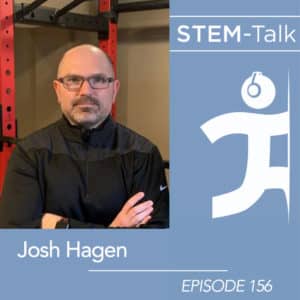STEM-Talk: Dr. Josh Hagen on performance lessons from athletes, warfighters
Published 8.23.23
Baseball may be America’s pastime, but it also is a data scientist’s dream.
Dr. Josh Hagen, director of the Human Performance Collaborative at Ohio State University, learned firsthand how deep the data mining well can go when it comes to tracking baseball player performance.

Hagen, who appears on Episode 156 of the STEM-Talk podcast, was part of a longitudinal study of changes in a baseball player’s maximal strength as a result of resistance training. The study focused on the impact the exercise had on total home runs per game across three years of training in four competitive seasons for four teams.
“Baseball is a fascinating sport when it comes to math and statistics,” Hagen says. “As far as American sports, baseball has gone head-first into statistics. I’ve been floored by the amount of staffing and infrastructure these teams have (around data)…. Every swing, every pitch is biomechanically analyzed.”
Hagen’s STEM-Talk is co-hosted by IHMC Founder Ken Ford and IHMC’s Chief Strategic Partnership Officer Dr. Morley Stone, who has had an instrumental role in Hagen’s career.
The conversation covers Hagen’s work at the Human Performance Collaborate, which brings together multidisciplinary teams of researchers, sports scientists, data scientists, and practitioners with the goal of optimizing human performance in Ohio State athletes.
Hagen credits his high school chemistry teacher who made chemistry lively and compelling, with kickstarting his scientific career. Even when the challenges of his first semester at the University of Cincinnati studying to be a chemical engineer became clear, Hagen decided to push on.
Hagen’s first job in private industry felt like a grind he couldn’t bear for the rest of his life.
“I was watching a more senior engineer doing the same things I was doing and he’d been doing it for 20 years. I just thought, ‘I don’t think I can do this for 20 years.’”
Advice from another trusted teacher led Hagen to pursue a Ph.D., which led to work at Wright Patterson Air Force Base, where he would first meet Stone. The rest is history.
Within human performance research, Hagen leads two areas: Sport and Tactical Performance Science and Recovery Science. At Ohio State, Hagen works with other performance science researchers to evaluate the physical traits and capabilities of athletes. They collaborate with coaches and athletic trainers to make adjustments in the weight room, on the field, and during recovery after training or competitions.
Hagen also works on federally funded projects with Special Operations Command, The Air Force Research Laboratory, the Office of Naval Research and several private foundations. He joined IHMC in 2022 as a Visiting Senior Research Scientist.
The conversation is wide-ranging and includes:
— How lessons Hagen learned from his time in the private sector, at the Air Force Research Laboratory, and at West Virginia University, fed into his work at Ohio State University as the director of the Human Performance Collaborative.
— Hopes that while his team largely works with two populations — sports athletes and the military — the applications of what they learn could be far-reaching. “We’re trying to maximize human performance for all humans, that sounds like a ridiculous, broad objective, but that is really what we’re trying to do,” Hagen said. “Every one of us can be optimized to some level.”
— What Hagen means by “the need to understand performance on a system level” and how training-load monitors work to create usable feedback for athletes.
— Hagen’s 2020 paper on monitoring neuromuscular performance in military personnel.
— Hagen’s study of popular commercial off-the-shelf wearables that give health data to consumers. The study looked at the accuracy of heart rate variability, sleep, and heart rate data that these devices track.
— Hagen’s study conducted on firefighters titled “Biomarker and Biometric Indices of Physical Exhaustion in the Firefighting Community.”
— Hagen’s work with the Air Force’s 711th Human Performance Wing on a project he has led for the past decade called STRONG (Signature Tracking for Optimized Nutrition and TraininG), which aims to develop physical training routines and nutritional approaches that can enhance a warfighter’s performance and resilience.
— An overview of IHMC’s research project that involves Hagen, Ohio State University, and the STRONG lab, called A2PEX (Assessing and Augmenting Performance in Extreme Environments). A2PEX aims for real-time assessment of a special operator’s cognitive performance over long-duration missions, often in extreme environments, as well as developing wearable devices and an integrated system that will help warfighters overcome fatigue and stress by continually sensing and assessing their performance.
IHMC is a not-for-profit research institute of the Florida University System where researchers pioneer science and technology aimed at leveraging and extending human capabilities. IHMC researchers and staff collaborate extensively with the government, industry and academia to help develop breakthrough technologies. IHMC research partners have included: DARPA, the National Science Foundation, NASA, Army, Navy, Air Force, National Institutes of Health, IBM, Microsoft, Honda, Boeing, Lockheed, and many others.
Latest News
- STEM-Talk: Ask Me Anything with Dr. Ken Ford
- David Bear joins IHMC Board of Directors
- STEM-Talk: Michael Schmidt on building a space-faring civilization
- Florida Blue award supports health and wellness research and outreach at IHMC
- STEM-Talk: Ken Forbus on AI and his development of the Structure Mapping Engine
- STEM-Talk: Pascal Lee on returning to the Moon — and heading to Mars
- Aging Symposium draws experts to IHMC
- IHMC hosts Fredric G. Levin Lung Care Symposium March 27-28 in Pensacola
- Humanoid robotics and exoskeletons lead latest IHMC newsletter

